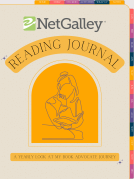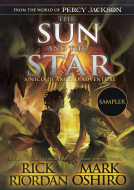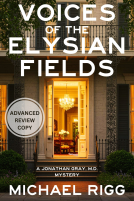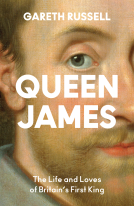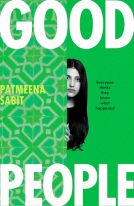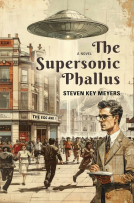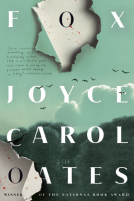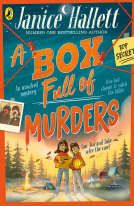
Murder at No. 4 Euston Square
The Mystery of the Lady in the Cellar
by Sinclair McKay
This title was previously available on NetGalley and is now archived.
Send NetGalley books directly to your Kindle or Kindle app
1
To read on a Kindle or Kindle app, please add kindle@netgalley.com as an approved email address to receive files in your Amazon account. Click here for step-by-step instructions.
2
Also find your Kindle email address within your Amazon account, and enter it here.
Pub Date 6 Jul 2021 | Archive Date 5 Aug 2021
Talking about this book? Use #MurderatNo4EustonSquare #NetGalley. More hashtag tips!
Description
Someone must have known what happened to Matilda Hacker.
For someone in that house had killed her.
So how could the murderer prove so elusive?
Standing four storeys tall in an elegant Bloomsbury terrace, No. 4, Euston Square was a well-kept, respectable boarding house. But beneath this genteel Victorian London veneer lay murderous intrigue. On 9 May 1879, the body of a former resident, Matilda Hacker, was discovered by chance in the coal cellar. The ensuing investigation – led by Inspector Charles Hagen, rising star of the recently formed CID – stripped bare the dark side of Victorian domesticity.
In this true-crime story, Sinclair McKay meticulously evaluates the evidence in first-hand sources. His gripping account sheds new light on a mystery that eluded Scotland Yard.
‘With the gusto of a penny dreadful, Murder at No. 4 Euston Road dodges any stodgy courtroom testimony that can weigh down true crime stories and sticks to the juicy details. It is hard to avoid the comparison with Kate Summerscale’s The Suspicions of Mr Whicher and it has similar historical richness and plot twisting…’ The Spectator
'Sinclair McKay is an accomplished and talented author with a rare skill... True crime fans and history buffs will enjoy this book, coming away with an enthralling true crime story and a new knowledge and understanding of Victorian London.' Crime Traveller
‘Gripping, gothic and deeply poignant’ Mail on Sunday
‘A meticulously researched book’ - Brian Viner, Daily Mail
Available Editions
| EDITION | Other Format |
| ISBN | 9780711255838 |
| PRICE | US$15.00 (USD) |
| PAGES | 320 |
Average rating from 40 members
Featured Reviews
I received this book for free for an honest review from netgalley #netgalley
I wish that this was available to be on my Kindle however it was a very interesting read. A ton of info on a topic that I really didn't know that much about. Plus a great presentation.
Many thanks to NetGalley and Aarum Press for providing me with a copy of this eARC in exchange for an honest review.
In the spirit of honesty, I should say that I have read this book before under its other title - The Lady in the Cellar - and I really enjoyed it. I love reading about Victorian England true crime cases, and this book not only focuses on the crime, but on life within the boarding house world in central London where class and status meant everything and sex was a four letter word. It also delves a little bit into what life was like as a servant, which I found super interesting.
It was clear both times I’ve read this that the author has put a lot of time into researching boarding houses, and centering this little-known murder makes the discussion all the more interesting and poignant - after all, the woman was missing for a lengthy period of time and there was nobody who cared enough to make waves about finding her, the lives of the landlords (and their wider family) at No. 4 were destroyed, and society seemed more interested in lurid detail than in the truth.
I also liked how the author has provided a couple of well thought out scenarios to present what they feel has likely happened, since there are competing stories and the truth will now never be revealed.
An absolutely fascinating look into a segment of Victorian London life and definitely worth a read for true crime or history buffs.
Suspense, horror, unanswered questions, layer upon layer of mystery and suspicion abound in this chilling book, giving me tingly goosebumps. Why? It is a true crime story about real people. At No. 4 Euston Square in Victorian London, a tasteful boarding house with a respectable address is the scene of something so sinister, so awful that it grabs the unwanted attention (though seemingly wanted by one) and imagination of people all over. This neighbourhood was known to be that of intellectuals. But what happens one day defies all logic...an boy preparing for coal delivery discovers something that would shatter everything from reputations to lives. Who was the body? Why was it there and how did it get there? And when?
The writing is brilliant, drawing on copious quotations of the real case. I appreciate the background history of boarding houses, industry, occupations and mentions of brilliant minds such as Thomas Hardy which sets thing up perfectly. The Bastendorff family who owned the boarding house were respected furniture builders. Mary and Severin had many children and it was Mary's responsibility to operate the boarding house and take in boarders. Their lives quickly turned upside down as the family members were suspect for various reasons. But there were other players including staff and boarders, past and present. I could almost taste the tension as people were pitted against each other. Inspector Charles Hagen thoroughly investigated and had his views. But so did others. So do I.
Mysteries within mysteries abound including allegations of impropriety, kleptomania and madness. If you are even minutely fascinated by Victorian era true crime, this riveting book is an absolute must. It prompted me to do further research and I could not stop mulling it over today.
My sincere thank you to Quarto Publishing Group, White Lion and NetGalley for the privilage of reading this remarkable, REMARKABLE book!
I found this interesting and Informative. I had no previous knowledge but I was completely taken in by the story. I do love victorian London true crime and this did not disappoint.
On May 9th, 1879, at No. 4, Euston Square boarding house a body was found in the coal cellar by the errand boy. The house was run by the Bastendorffs. The obvious crime was investigated by Inspector Hagen of the CID. The body was so grotesquely decomposed that it made identification very difficult. It was eventually identified as Matilda Hacker, who was a previous tenant. The book follows the investigation and is a rather good true crime read. It contains some good information on this Victorian-age murder and is well researched. I really enjoy this type of old British true crime book. Advance electronic review copy was provided by NetGalley, author Sinclair McKay, and the publisher.
Murder at No. 4 Euston Square: The Mystery of the Lady in the Cellar by Sinclair McKay is just the kind of true crime I enjoy: historical, full of intrigue, and the well-researched work of an experienced historian. Not only is this crime compelling, but McKay does not miss a single detail in his account of a baffling murder that goes far beyond a simple whodunit.
The text centers on a four storey Victorian building at No. 4 Euston Square in London, England. Owned and operated by the Bastendorffs, the building served—as many did in the nineteenth century—as a boarding house for either long- or short-term travellers. The Bastendorffs, Severin Bastendorff a German immigrant, felt that their financial and social prospects were good in the spring of 1879. However, on the 9 May that year, things changed and suddenly the darker, very private business of the Bastendorffs, as well as the business of their staff and lodgers, would come under uncomfortable scrutiny. In the coal cellar of the boarding house, the nearly skeletal remains of local eccentric Matilda Hacker were found buried underneath a large pile of coal. Hacker was a former tenant at the Bastendorff’s lodging house, and one who, the household reported, had mysteriously and suddenly left her rooms. Left to decompose for some time, questions immediately arose as to who would have had the motive, means, and opportunity to commit this crime. Scotland Yard eventually zeroed in on the occupants of the house on Euston Square.
The research throughout this book is impeccable. Not only does McKay rely extensively on personal and public documents from the period of the murder and the surrounding years, but there is also a clear effort to paint a broader picture of Victorian culture at the time. The social, political, and financial positions of the players in this story are rendered in minute detail to give a real sense of the conflicts and motivations that certain characters might have faced. While the broad strokes of this story are compelling on their own, McKay peels back the façade of No. 4 Euston Square to reveal the inner workings of a home with a dark secret that belies gentility. McKay recounts the various narrative stereotypes present in the literary culture of the time around boarding houses and their various archetypes; the proliferation of these types, the text posits,
…struck at the very heart of the nature of the boarding house; in the early and mid-Victorian years, with an expanding middle class, there was a concomitant rising sense that the ideal home should be a detached sanctuary: a place where one family dwelled under one roof, in domestic stability, sheltered in every sense from the chaos of the world. Rising middle-class affluence brought a rising taste for privacy. The boarding house, by contrast, introduced a measure of enforced proximity with strangers; total privacy was a practical impossibility (51).
A subtle strength in McKay’s text is the setup of various binaries that are constantly troubled throughout the case: private and public, inside and outside, passive and active. For Victorians, McKay points out, the rise of the nineteenth-century lodging house began to confuse the boundaries of public/private space. By letting strangers into your home to live, work, and eat, and in-effect by then creating a form of business within the home, the public/private boundaries that the Victorians championed were no longer so simple. McKay’s text narrates the worst-case-scenario of this kind of fear: murder and all of the twists and turns that follow the investigation.
However, McKay’s text is not a simple one and the crime does not have a simple answer. Hacker’s murder is the catalyst for a number of discoveries, accusations, and indictments; the residents of No. 4 each point fingers at each other and a larger scandal of sex, money, and violence emerges. Drawing on trial records and the press coverage of the salacious case from the period, McKay expertly leads the reader through the twists and turns in this case—even when we aren’t sure who we should believe.
Murder at No. 4 Euston Square is essential reading for anyone interested in historical true crime with fascinating twists, and for anyone compelled by the social and cultural landscape of the nineteenth century.
Please add Murder at No. 4 Euston Square to your Goodreads shelf.
Don’t forget to follow True Crime Index on Twitter and please visit our Goodreads for updates on what we’re reading! You can find Rachel on her personal @RachelMFriars or on Goodreads @Rachel Friars.
About the Writer:
Rachel M. Friars (she/her) is a Doctoral Candidate in the Department of English Language and Literature at Queen’s University in Kingston, Ontario. She holds a BA and an MA in English Literature with a focus on neo-Victorianism and adaptations of Jane Eyre. Her current work centers on neo-Victorianism and nineteenth-century lesbian literature and history, with secondary research interests in life writing, historical fiction, true crime, popular culture, and the Gothic. Her academic writing has been published with Palgrave Macmillan and in The Journal of Neo-Victorian Studies. She is a reviewer for The Lesbrary, the co-creator of True Crime Index, and an Associate Editor and Social Media Coordinator for PopMeC Research Collective. Rachel is co-editor-in-chief of the international literary journal, The Lamp, and regularly publishes her own short fiction and poetry. Find her on Twitter and Goodreads.
A copy of this book was graciously provided by the publisher in exchange for an honest review.
 Gemma M, Reviewer
Gemma M, Reviewer
Such an interesting and well researched book. I love True Crime so this was a perfect read for me.
The story was written in such a different way so it kept the reader hooked until the end.
 Reviewer 266180
Reviewer 266180
Mystery, Madness And Murder Abound…
Mystery, madness and murder abound in this meticulously researched account of a true crime in Victorian London. It’s an altogether dark but fascinating tale presented in an altogether readable fashion with an interesting evaluation of the available evidence.
I didn't realise when I requested this one that it was a book I had read before under a different title. Here's my review from the original read anyway:
When a body is found in the cellar of 4 Euston Square, in Victorian London it sets off a chain reaction of far reaching consequences. Matilda Hacker was an eccentric older lady who rented a room at no. 4 - the home of the Bastendorff family. She was only there a matter of weeks before suddenly taking her leave and disappearing. Did the Bastendorffs have something to do with her disappearance or was their maid, the last person to see Ms Hacker alive, involved?
Victorian Britain is one of my favourite eras to read about and this book was not a disappointment. I thoroughly enjoyed this reconstruction of the events and characters that appeared in this true crime account. The level of research was plain to see in the detail that was provided by the author, but it never became dry and dull to read. On the contrary, the twists of the court case and the fallout were enthralling. The only criticism I have is that the conclusion seemed a little rushed to me but this is a minor quibble overall.
Thanks to NetGalley and publishers, Quarto Publishing Group - White Lion Publishing, for the opportunity to review an ARC.
Interest and well written book. I will definitely be on the lookout for more by this author. Thanks to publisher and NetGalley for this ARC!
I really enjoyed this book! It was a great read, i didnt want to put it down! I would recommend this to my friends and family
 Librarian 431790
Librarian 431790
A gripping, well researched and entertaining true crime story that kept me hooked.
I appreciated the historical part and the details about the investatigation.
An excellent book.
Highly recommended.
Many thanks to the publisher and Netgalley for this ARC, all opinions are mine
I love true crime and Victorian times so this book is right up my alley.
The story is intriging to say the least. The author did amazing research getting information from police interviews, court transpcripts and newspaper articles. The pacing was wonderful and turned into a quick read for me.
All in all I really enjoyed this book. I will be looking for more from this author.
 Emma A, Educator
Emma A, Educator
Oh this was good. So, so good. I couldn’t put it down. I love a mystery but this had so many twists and turns I just couldn’t guess who did it. I absolutely loved it. Very well researched, extremely well written. Thank you for letting me review this book. I thoroughly recommend it.
 Mardi D, Librarian
Mardi D, Librarian
I want "elderly maiden" inscribed on my tombstone. And my obituary to read 'she was "colourful, aggravating, and often madly impetuous,".... "prone to quarrelsome chaos," and possessed of "a streak of pure, almost reflexive irresponsibility...."
Bless Matilda Hacker's heart, she was eccentric in life and remained odd and unusual even in the manner of her death and discovery. More than just your average true crime story, this book had me questioning how long I could be dead before my brother missed me (Matilda's brother hadn't heard from her in a while--she'd been dead for TWO YEARS!) and go off on innumerable little side quests to find out more about Victorian life (imagine a blazing coal fire in the middle of summer because that's the only way you have hot water).
This book will appeal to both true crime fans and history buffs. I was putting patrons on hold for it before I'd even finished it! For a librarian, this book is gold. As a reader, I did find the recounting of witness statements and testimony a bit tedious. However, that nitty gritty detail is one of the things that sets this book apart many other retellings of historic crimes. McKay doesn't just rely on old newspaper reports for his recounting. Very well-researched and a fascinating read!
Readers who liked this book also liked:
Rick Riordan; Mark Oshiro
Children's Fiction, LGBTQIA, Teens & YA

